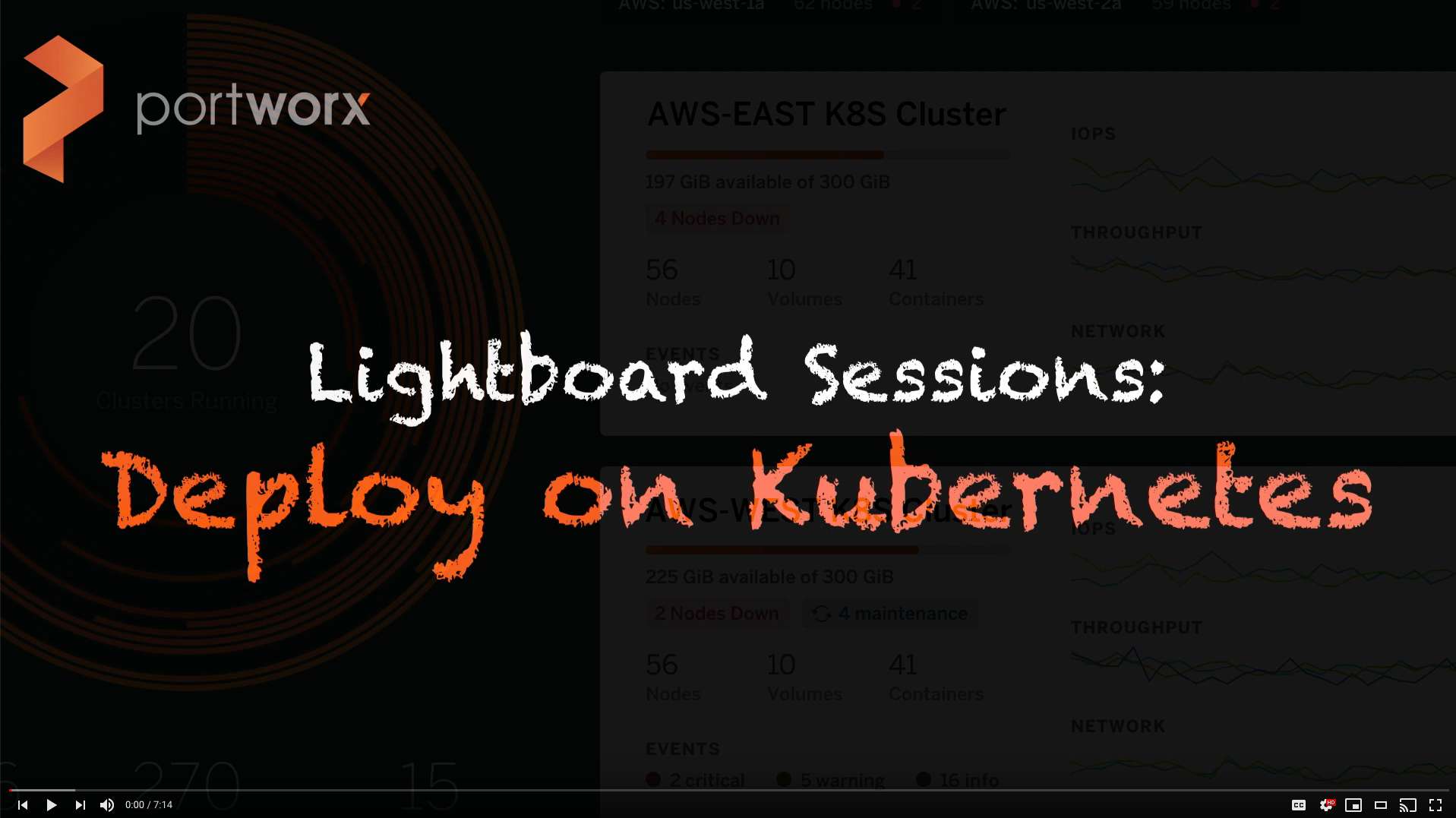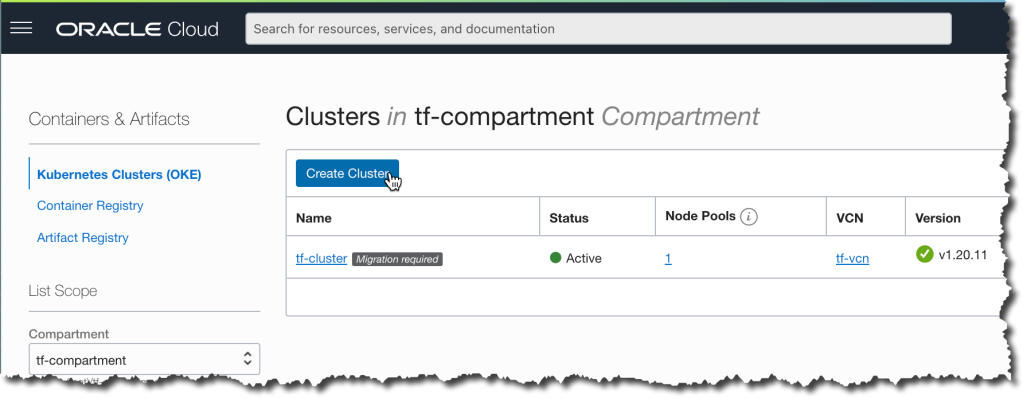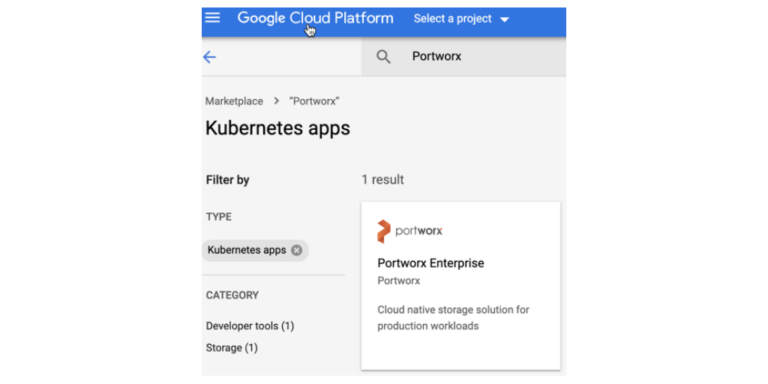Portworx Guided Hands On-Labs. Register Now

With the release of Portworx 2.13, Cloud Drives support is now generally available for the Oracle Cloud Infrastructure (OCI) managed Kubernetes service Oracle Container Engine for Kubernetes (OKE). Portworx Cloud Drives provides the ability to automatically provision and scale storage. This is great news for anyone using Portworx on OKE, as it means we no longer need to pre-create OCI Block Volumes and attach them to the OKE worker nodes before installing Portworx.
So, let’s see how much simpler it is to deploy Portworx with Cloud Drives.
Oracle Kubernetes Engine (OKE) Cluster
For this blog post, I will be using a 3-node v1.25.4 Kubernetes cluster, which I have created using the OKE Wizard within the uk-london-1 region, as shown below.
kubectl get nodes -L topology.kubernetes.io/region,topology.kubernetes.io/zone NAME STATUS ROLES AGE VERSION REGION ZONE 10.0.10.127 Ready node 2m3s v1.25.4 uk-london-1 UK-LONDON-1-AD-2 10.0.10.13 Ready node 2m9s v1.25.4 uk-london-1 UK-LONDON-1-AD-3 10.0.10.16 Ready node 2m2s v1.25.4 uk-london-1 UK-LONDON-1-AD-1
OKE Storage Classes
OCI provides two Kubernetes storage classes: oci, and oci-bv. The oci block volume (oci-bv) is now the default and is used by the CSI volume plugin. The oci class is considered legacy and is only used by the FlexVolume plugin.
kubectl get sc NAME PROVISIONER RECLAIMPOLICY VOLUMEBINDINGMODE ALLOWVOLUMEEXPANSION AGE oci oracle.com/oci Delete Immediate false 5m47s oci-bv (default) blockvolume.csi.oraclecloud.com Delete WaitForFirstConsumer true 5m47s
Portworx Namespace
Before we do anything, let’s create a dedicated namespace for Portworx using kubectl create ns.
kubectl create ns portworx namespace/portworx created
Portworx OKE Secret
To install the Portworx Operator, we need to create a Kubernetes secret to allow Portworx to manage OCI block storage using our Oracle API signing key and fingerprint details, for example.
kubectl create secret generic ociapikey \ --namespace <namespace> \ --from-file=oci_api_key.pem=/Users/rekins/.oci/oci_api_key.pem \ --from-literal=PX_ORACLE_user_ocid="<ocid>" \ --from-literal=PX_ORACLE_fingerprint="<fingerprint>"
Check to be sure the secret has been created in the correct namespace.
kubectl get secret -n portworx NAME TYPE DATA AGE Ociapikey Opaque 3 9s
Portworx Central
Visit https://central.portworx.com and log on, then select Portworx Enterprise, and then select Portworx Essentials or Portworx Enterprise. We can see the spec generator now includes Oracle as a Cloud option; select Oracle.
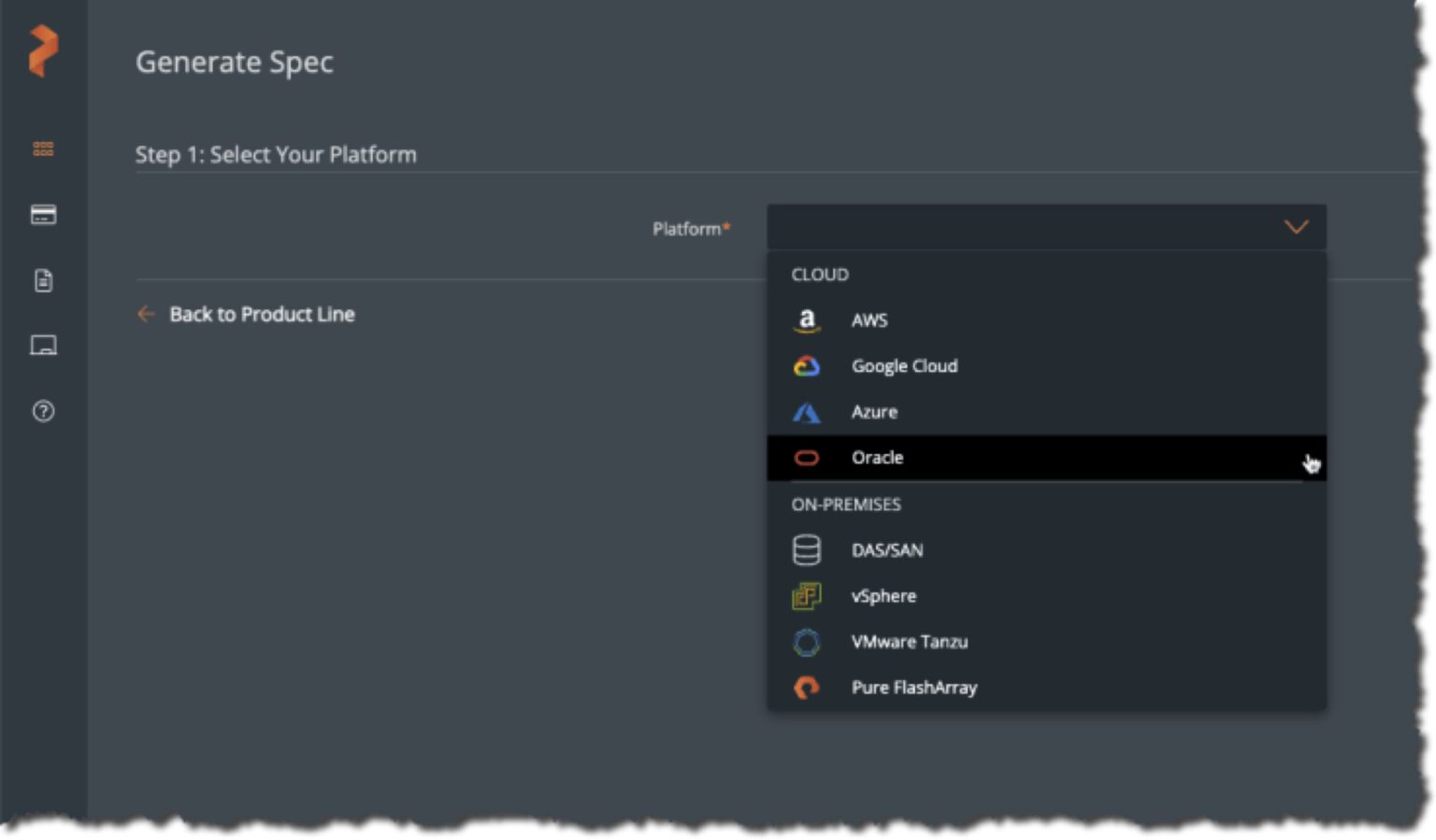
Confirm the Kubernetes namespace.
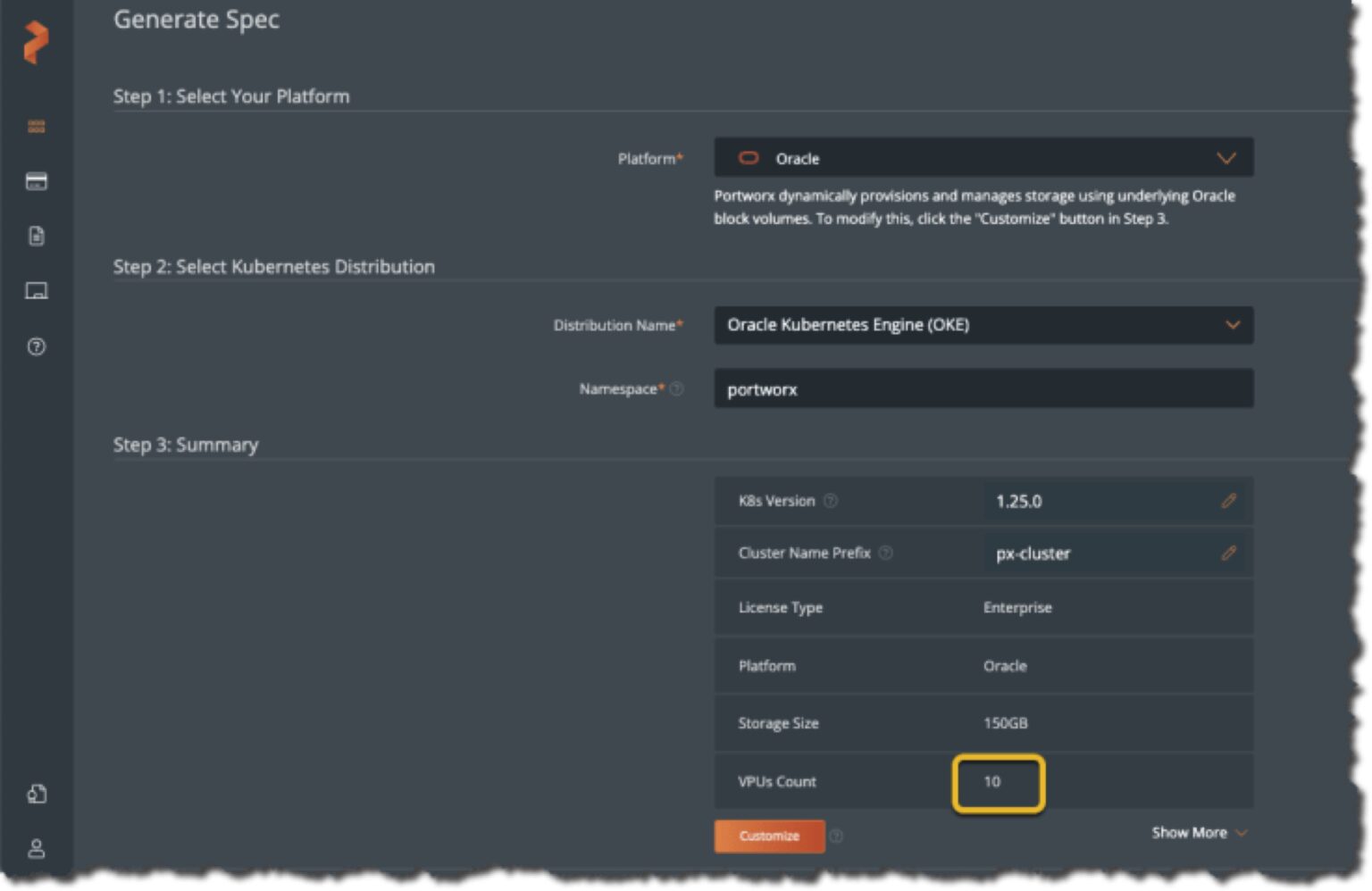
Review the Summary and click Show More if required. Take special notice of the Storage Size and VPUs Count and set them to match application performance requirements. The tables below are provided for reference.
Performance Characteristics
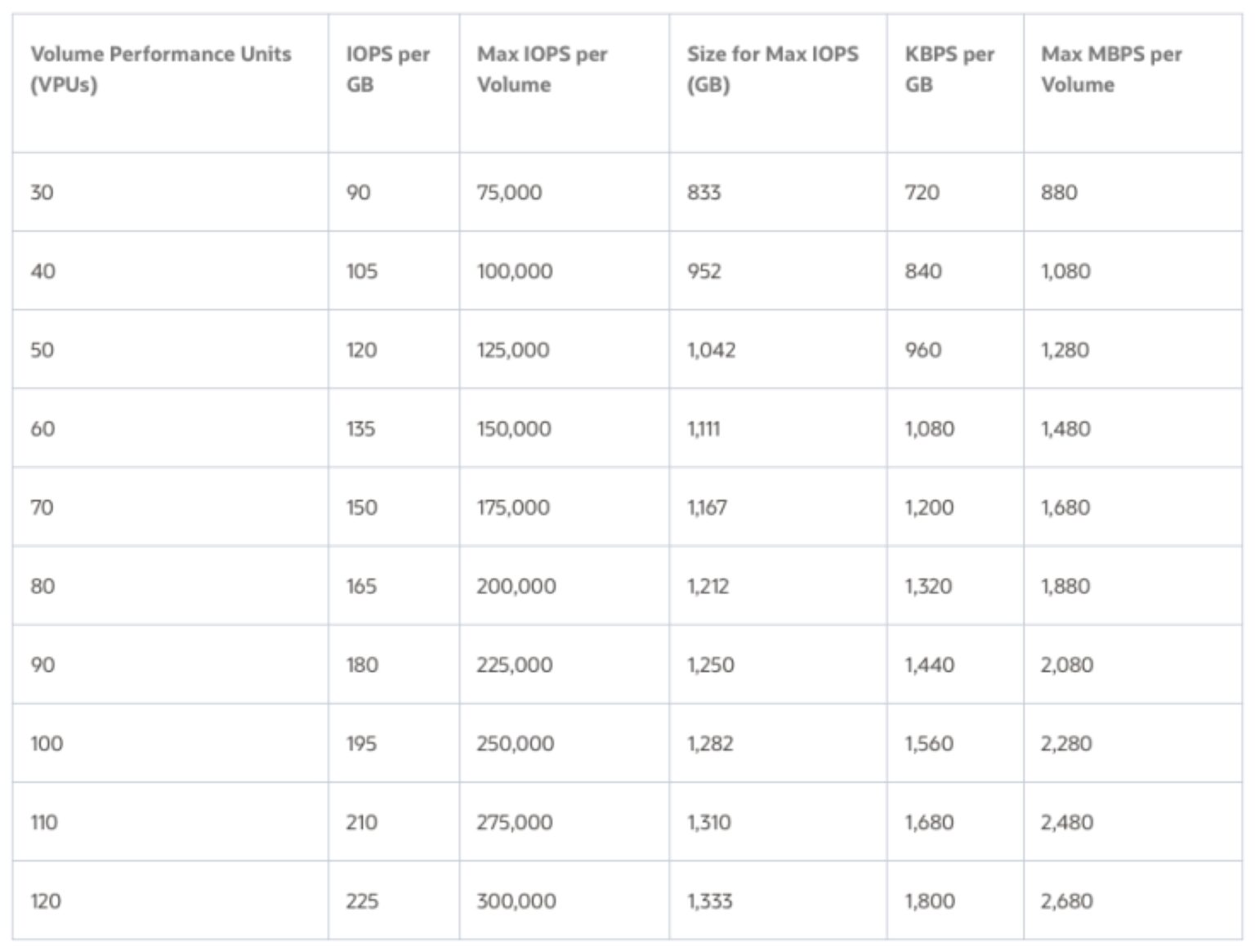
Volume Size and Performance
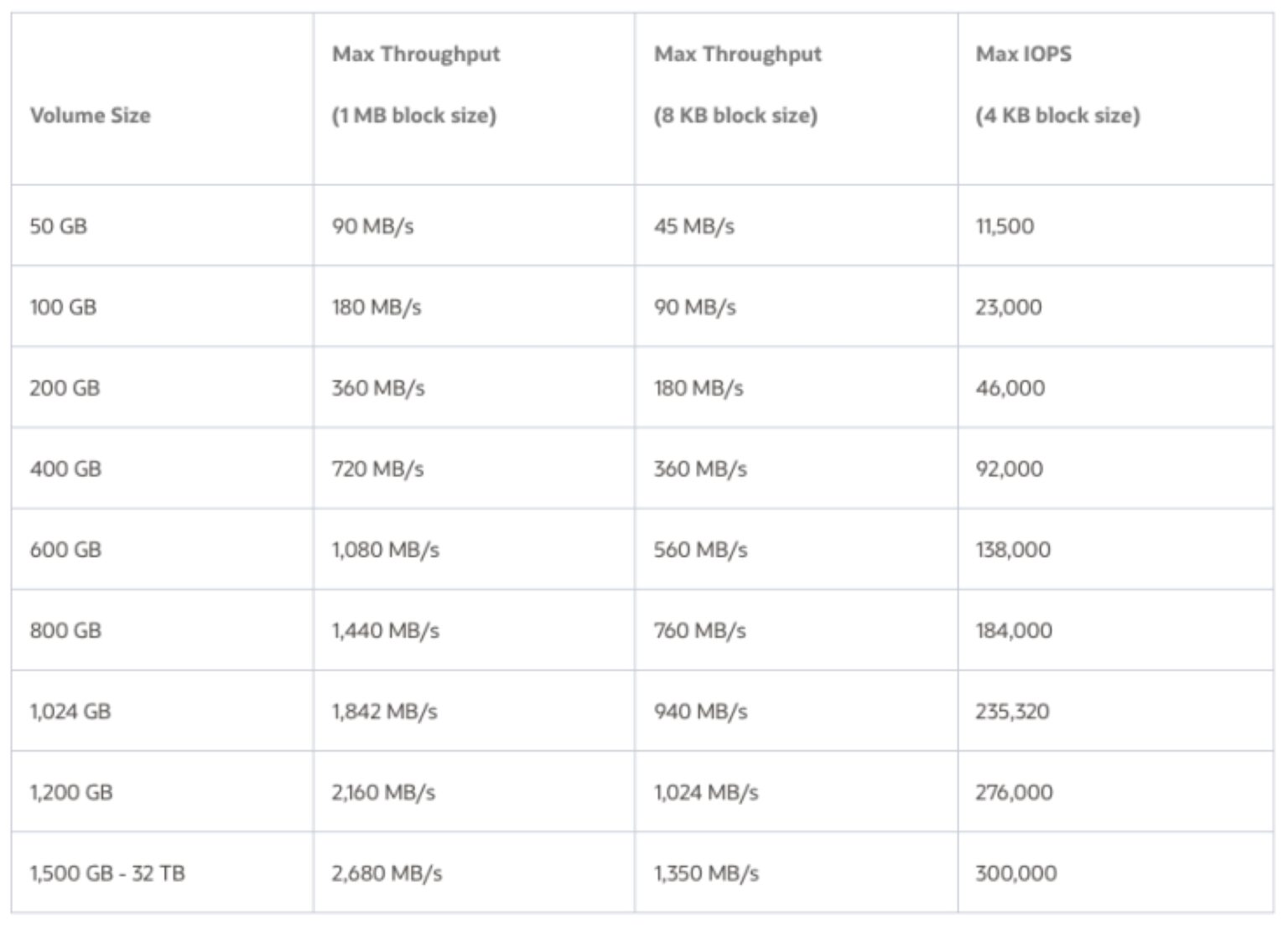
Complete the wizard and grab the Portworx deployment commands.
Deploy Portworx Operator
To install the Portworx Operator use
kubectl apply -f 'https://install.portworx.com/2.13?comp=pxoperator&kbver=1.25.4&ns=portworx' serviceaccount/portworx-operator created clusterrole.rbac.authorization.k8s.io/portworx-operator created clusterrolebinding.rbac.authorization.k8s.io/portworx-operator created deployment.apps/portworx-operator created
Deploy Portworx StorageCluster
To deploy the StorageCluster, use the second command provided by PX-Central:
kubectl apply -f 'https://install.portworx.com/2.13?operator=true&mc=false&kbver=1.25.4&ns=portworx&b=true&kd=type%3Dpv-10%2Csize%3D150&cp=oracle&s=%22type%3Dpv-20%2Csize%3D150%22&c=px-cluster-888de70e-bdc2-4761-99db-7c306df72e97&oke=true&stork=true&csi=true&mon=true&tel=false&st=k8s&promop=true' storagecluster.core.libopenstorage.org/px-cluster-888de70e-bdc2-4761-99db-7c306df72e97 created
Portworx Storage Class
Using kubectl get sc, we can see a number of new storage classes have been created by Portworx:
kubectl get sc NAME PROVISIONER RECLAIMPOLICY VOLUMEBINDINGMODE ALLOWVOLUMEEXPANSION AGE oci oracle.com/oci Delete Immediate false 166m oci-bv (default) blockvolume.csi.oraclecloud.com Delete WaitForFirstConsumer true 166m px-csi-db pxd.portworx.com Delete Immediate true 2m13s px-csi-db-cloud-snapshot pxd.portworx.com Delete Immediate true 2m12s px-csi-db-cloud-snapshot-encrypted pxd.portworx.com Delete Immediate true 2m12s px-csi-db-encrypted pxd.portworx.com Delete Immediate true 2m13s px-csi-db-local-snapshot pxd.portworx.com Delete Immediate true 2m12s px-csi-db-local-snapshot-encrypted pxd.portworx.com Delete Immediate true 2m12s px-csi-replicated pxd.portworx.com Delete Immediate true 2m13s px-csi-replicated-encrypted pxd.portworx.com Delete Immediate true 2m12s px-db kubernetes.io/portworx-volume Delete Immediate true 2m13s px-db-cloud-snapshot kubernetes.io/portworx-volume Delete Immediate true 2m13s px-db-cloud-snapshot-encrypted kubernetes.io/portworx-volume Delete Immediate true 2m13s px-db-encrypted kubernetes.io/portworx-volume Delete Immediate true 2m13s px-db-local-snapshot kubernetes.io/portworx-volume Delete Immediate true 2m13s px-db-local-snapshot-encrypted kubernetes.io/portworx-volume Delete Immediate true 2m13s px-replicated kubernetes.io/portworx-volume Delete Immediate true 2m13s px-replicated-encrypted kubernetes.io/portworx-volume Delete Immediate true 2m13s stork-snapshot-sc stork-snapshot Delete Immediate true 2m19s
Portworx Cluster Status
Using pxctl status, we can see a summary of the deployment.
PX_POD=$(kubectl get pods -l name=portworx -n portworx -o jsonpath='{.items[0].metadata.name}')
kubectl exec -it $PX_POD -n portworx -- /opt/pwx/bin/pxctl status
Defaulted container "portworx" out of: portworx, csi-node-driver-registrar
Status: PX is operational
Telemetry: Disabled or Unhealthy
Metering: Disabled or Unhealthy
License: Trial (expires in 31 days)
Node ID: 93b4f96a-292c-4e1a-8184-0399288ff823
IP: 10.0.10.127
Local Storage Pool: 1 pool
POOL IO_PRIORITY RAID_LEVEL USABLE USED STATUS ZONE REGION
0 HIGH raid0 150 GiB 9.5 GiB Online UK-LONDON-1-AD-2 uk-london-1
Local Storage Devices: 1 device
Device Path Media Type Size Last-Scan
0:1 /dev/sdb STORAGE_MEDIUM_SSD 150 GiB 27 Feb 23 16:37 UTC
total - 150 GiB
Cache Devices:
* No cache devices
Kvdb Device:
Device Path Size
/dev/sdc 150 GiB
* Internal kvdb on this node is using this dedicated kvdb device to store its data.a
Cluster Summary
Cluster ID: px-cluster-888de70e-bdc2-4761-99db-7c306df72e97
Cluster UUID: 9354debc-188a-4bf6-8470-015daf6af996
Scheduler: kubernetes
Nodes: 3 node(s) with storage (3 online)
IP ID SchedulerNodeName Auth StorageNode Used Capacity Status StorageStatus Version Kernel OS
10.0.10.16 c4b3011d-0a65-433c-869f-176b0f0bdacc 10.0.10.16 Disabled Yes 9.5 GiB 150 GiB Online Up 2.13.0-9793db5 5.4.17-2136.314.6.2.el8uek.x86_64 Oracle Linux Server 8.6
10.0.10.127 93b4f96a-292c-4e1a-8184-0399288ff823 10.0.10.127 Disabled Yes 9.5 GiB 150 GiB Online Up(This node) 2.13.0-9793db5 5.4.17-2136.314.6.2.el8uek.x86_64 Oracle Linux Server 8.6
10.0.10.13 6bbf1b2c-054e-4739-a464-7b2669595cad 10.0.10.13 Disabled Yes 9.5 GiB 150 GiB Online Up 2.13.0-9793db5 5.4.17-2136.314.6.2.el8uek.x86_64 Oracle Linux Server 8.6
Global Storage Pool
Total Used : 29 GiB
Total Capacity : 450 GiB
The pxctl cluster provision-status command lists the Portworx storage pools in the cluster.
pxctl cluster provision-status Defaulted container "portworx" out of: portworx, csi-node-driver-registrar NODE IP NODE STATUS POOL POOL STATUS IO_PRIORITY SIZE AVAILABLE USED PROVISIONED ZONE REGION RACK 6bbf1b2c-054e-4739-a464-7b2669595cad 10.0.10.13 Up 829b1d90-20cb-450c-85fa-422c620faa93 Online HIGH 150 GiB 140GiB 9.5 GiB 0 B UK-LONDON-1-AD-3 uk-london-1 93b4f96a-292c-4e1a-8184-0399288ff823 10.0.10.127 Up 41f1e1a9-a00f-4a04-bb5e-506dc90453f2 Online HIGH 150 GiB 140GiB 9.5 GiB 0 B UK-LONDON-1-AD-2 uk-london-1 c4b3011d-0a65-433c-869f-176b0f0bdacc 10.0.10.16 Up 75bd75e6-14ee-4689-a59e-5482ca878c18 Online HIGH 150 GiB 140GiB 9.5 GiB 0 B UK-LONDON-1-AD-1 uk-london-1
The pxctl clouddrive command is useful for getting more insight into the OCI block volumes provisioned by Portworx, including the OCID for each block volume.
pxctl clouddrive list Defaulted container "portworx" out of: portworx, csi-node-driver-registrar Cloud Drives Summary Number of nodes in the cluster: 3 Number of storage nodes: 3 List of storage nodes: [6bbf1b2c-054e-4739-a464-7b2669595cad 93b4f96a-292c-4e1a-8184-0399288ff823 c4b3011d-0a65-433c-869f-176b0f0bdacc] List of storage less nodes: [] Drive Set List NodeID InstanceID Zone State Drive IDs 6bbf1b2c-054e-4739-a464-7b2669595cad ocid1.instance.oc1.uk-london-1.anwgiljs54aw2uacoz4uqw7ks7kmz7ieucs2vw34wg5zgf5yrhorxaokgbpq iXvO:UK-LONDON-1-AD-3 In Use ocid1.volume.oc1.uk-london-1.abwgiljs5l7eoilq7q5rvfmuxwzjyhxxdzzntoghxqhngrw2hv2ex6g4im6a(kvdb),ocid1.volume.oc1.uk-london-1.abwgiljse6z2b4oq2jzaefu3l5ncxol6wvtlogabbj372wxtxa2u67mstspq(data) 93b4f96a-292c-4e1a-8184-0399288ff823 ocid1.instance.oc1.uk-london-1.anwgiljt54aw2uacmuqthy2zliqowvyxfidcginnd2zwhku5ofb62pzd2qpa iXvO:UK-LONDON-1-AD-2 In Use ocid1.volume.oc1.uk-london-1.abwgiljtknazvy2mdy3exkh3f56uatd4tuqqge2okoy224nox34o7piqlopq(data),ocid1.volume.oc1.uk-london-1.abwgiljtzvjmlawkiesffretu77s4itj65ux7lzrkc3ygw7ojhhoo4ngfypq(kvdb) C4b3011d-0a65-433c-869f-176b0f0bdacc Ocid1.instance.oc1.uk-london-1.anwgiljr54aw2uacxedxr2zlwe2zbzpca53arexhoe3ywrkbouobu5vyhaq iXvO:UK-LONDON-1-AD-1 In Use Ocid1.volume.oc1.uk-london-1.abwgiljrkqnshvfqur22lrvfzw2btha7524z7f2qwm74hizoxpjyadk4wa(data),ocid1.volume.oc1.uk-london-1.abwgiljrzjp6nzdqewmzwdpnugkk74y6o5ry7li2szhbuhvoa5eh444a(kvdb)
Portworx has automatically created a block volume in each of my three availability domains and attached it to the worker nodes as per the image below.
Use oci bv volume list command with –lifecyle-state “Available” to list OCI block volumes in a JSON format, for example, to see only display-name.
oci bv volume list --compartment-id <compartment id> --lifecycle-state "Available" | grep display-name "display-name": "PX-DO-NOT-DELETE-px-cluster-888de70e-bdc2-4761-99db-7c306df72e97-b283075a-9654-465e-ad98-2ec24ddbf964", "display-name": "PX-DO-NOT-DELETE-px-cluster-888de70e-bdc2-4761-99db-7c306df72e97-00766bb2-7b80-495f-9e0e-efef58093e8b", "display-name": "PX-DO-NOT-DELETE-px-cluster-888de70e-bdc2-4761-99db-7c306df72e97-75797196-bfe2-42ae-ac44-81ca5779c919", "display-name": "PX-DO-NOT-DELETE-px-cluster-888de70e-bdc2-4761-99db-7c306df72e97-43ba8ca6-29a0-4d24-8510-c7b4d86cdb5c", "display-name": "PX-DO-NOT-DELETE-px-cluster-888de70e-bdc2-4761-99db-7c306df72e97-960dd658-7fe0-4d58-8e11-50d0fd1bd1c9", "display-name": "PX-DO-NOT-DELETE-px-cluster-888de70e-bdc2-4761-99db-7c306df72e97-6a198ba1-f5c7-4a4f-b6a8-e53faa11544e",
Alternatively, return to the OCI console to see the newly created block volumes.
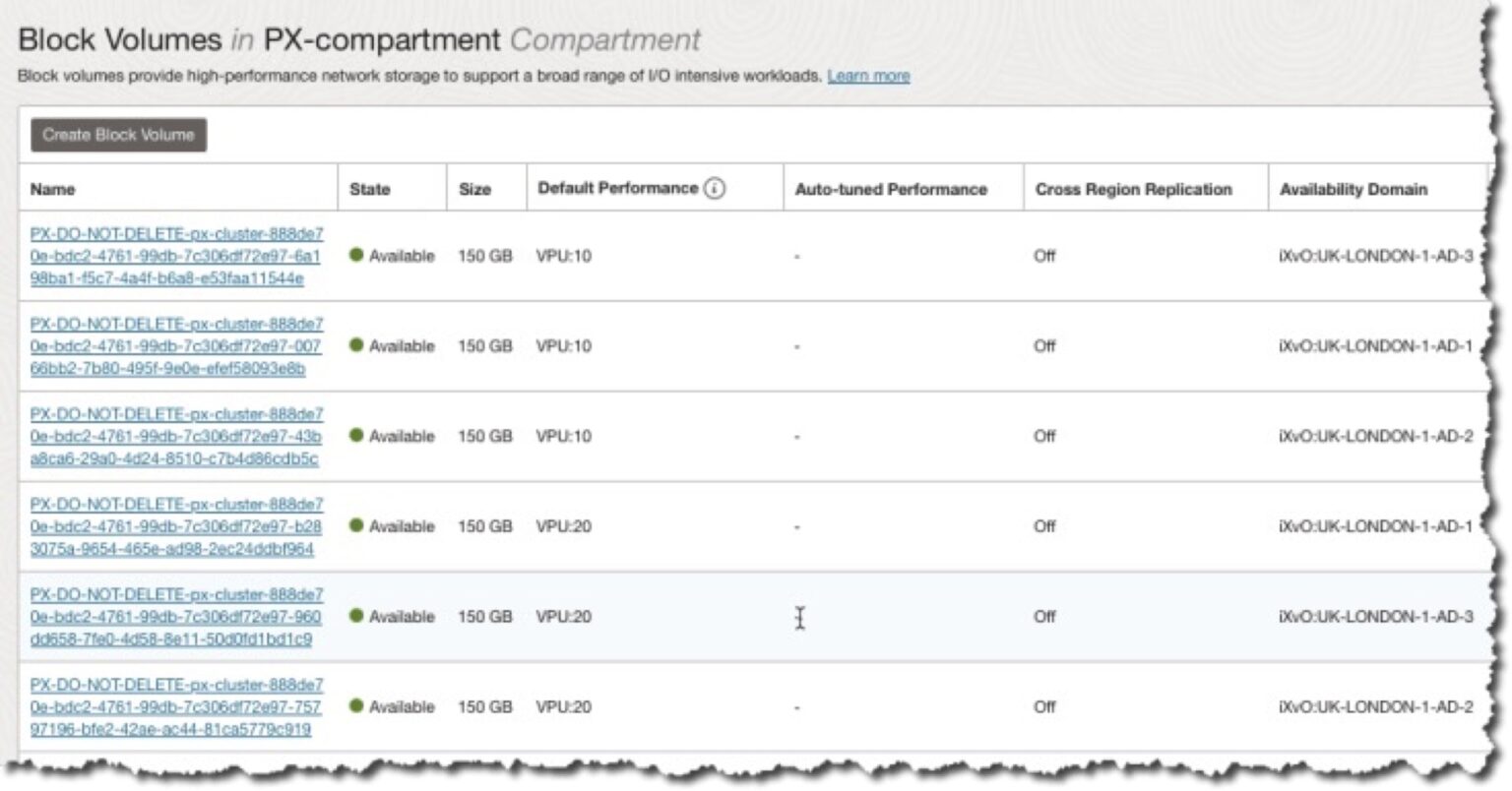
Navigate to the compute instance to confirm the Block Volume, Device Path, the way it’s attached, Access mode, Size and volume performance (VPU).
 Attached block volumes
Attached block volumes
Summary
In this post, we have shared how to install Porworx Enterprise 2.13 on OKE and demonstrated the automated provisioning of OCI Block Storage, which is now possible with the support of Portworx Cloud Drives.
Learn more about why Portworx is the gold standard when it comes to Kubernetes Storage and Data Management by downloading the 2022 GigaOM Radar for Enterprise Kubernetes Data Storage.
Share
Subscribe for Updates
About Us
Portworx is the leader in cloud native storage for containers.
Thanks for subscribing!

Ron Ekins
Principal Field Solutions ArchitectExplore Related Content:
- cloud drives
- oke
- oracle cloud


